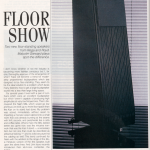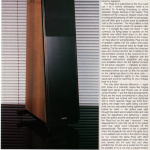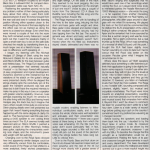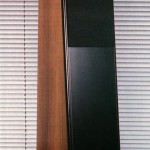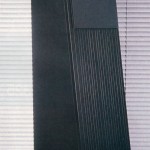Reproduced from “Hi-Fi Review” published in November 1989.
Floor Show
Two new floor-standing speakers from Rega and Royd. Malcolm Steward plays spot-the-difference.
I don’t know whether or not the industry is becoming more fashion conscious but I, for one, thoroughly approve of the emergence of what I hope will become a trend for moderately proportioned loudspeakers which are designed to be floor-standing. They seem to be the ideal solution to a problem which faces many listeners. How to get a large-loudspeaker sound into a less than large living space.
For several years I lived with a pair of Linn Kans which were an excellent loudspeaker but which weren’t capable of producing high amplitudes at very low frequencies. Then I discovered the Naim SBL which would go low and loud, yet took up no more floor-space than the Kan on its stand had done. My problem was solved immediately without resort to importing a monster sized cabinet into a small room that was already bursting at the seams with hi-fi, records, and peripherals like a sofa and coffee table. What’s more the SBL looked better too gone now was the intrusive ironwork that was the Kan II stand – a necessary item but not one that could be described as attractive-looking – and its solid structure hid the cabling as well. This trend continued for Naim with the addition to the range of the IBL, a miniature version of the first speaker, built upon the same lines. And Linn have recently introduced their all-in-one contender, the Kaber
The only drawback, if it can be described as such, is the price of this aural and aesthetic satisfaction. the SBL costs £1242 and the IBL £690 (both in passive form), and Linn’s offering is only a few pounds short of the £1000 mark. All these speakers need respectable – for which read not inexpensive – amplification too.
However, two recent additions to the scene look set to bring the price of admission down below the £500 point. The Royd Loudspeaker Company’s Apex comes in at £485 and Rega’s ELA is cheaper still at a very reasonable £405. Furthermore, and despite the fact that these speakers will improve in step with the amplification used, they both make only modest demands on the amplifier driving them, so use with a respectable integrated isn’t out of the question. This makes them highly suited to those who don’t wish to fork out large amounts for pre/power amplifiers before they improve their speakers.
Our photos will no doubt make it apparent that there is some slight external resemblance twixt the two speakers. Physically, ignoring cosmetic individualities, they are as alike as can be. The Rega ELA measures 800mm high (minus stand), is 300mm deep at its biggest point (the base) and 200mm wide. The Royd Apex stands a fraction taller at 825mm (including stand) but that is the only dimensional difference
Both speakers feature transmission line loading to assist with the reproduction of bass frequencies. The lines vent via rearward facing apertures at the top of the cabinets. Both employ two drive units: in the Royd that’s a 19mm Scanspeak tweeter paired with one of their own 5 inch bass/midrange drivers; the Rega I know has a sourced-from-Royd bass/ mid unit of about 5 inches in diameter, and its tweeter looks very Scanspeak-like. Actual comparisons are hindered by the fact that the Royd has a fixed grille cloth. The Rega, however, has a cloth grille attached to a wire frame which is removable; they recommend that this is left in place to prevent the build up of dust which can occur on the units – the bass/mid has no dust cap and although the grille cloth will not keep everything out it will prevent some air-borne domestic debris from entering the unit. The Royds are marked as a handed pair and should be used as such. The Regas, although they sport asymmetrically laced tweeters, can be used with tweeters ‘outside’ or ‘inside’.
In a conversation I had with Joe Akroyd, who designed the Apex, he did intimate that at the early stages of the design he and Rega were working In some sort of cooperation, having discovered that they were both working an a similar idea for a speaker. Later on, however, the two designs diverged. They both have similar cabinets with similar transmission lines, and both use similar drivers, but the crossover used in each speaker, for example, is radically different. Rega have opted for an elementary, minimalist design whereas the Royd uses a more complex, 18dB/octave (third order) type. The reasons for this will become apparent.
The Rega ELA subscribes to the ‘buy it and use it as it comes’ philosophy: there is no provision for bi-wiring, bi-amping, or active operation. Rega’s literature in fact states. “This simplicity (of the crossover designs means that bi-wiring and bi-amping will offer no advantage, and will often give a worse result at additional cost to the customer”. The Royd differs in that its crossover is sited outside the speaker cabinet – it actually fits inside the stand – and connects via flying leads to sockets on the cabinet rear which feed direct to the drive units. Two sets of 4mm sockets on the crossover input allow for wiring flexibility. Plug one set of speaker cables into the yellow and black sockets on the crossover input for single wire working. Cut the wire links under the crossover base and connect another set of cables to the red and black sockets on the crossover for biwire or bi-amp mode. Or dispense with the crossover connections altogether and plug your amplifiers direct into the cabinet sockets for full active operation – naturally an electronic crossover in front of your power amps is necessary before you can do this: the sockets on the cabinet go direct to the drive units – connect a bass/mid signal to the tweeter inputs and you’ll be reaching for your cheque book in a hurry!
The only other obvious difference – apart from those of a cosmetic nature like Rega’s fluted front panel, and Royd’s use of wood veneer finishes – are the stand arrangements. Royd are the more conventional in using four spikes which are locked with nuts tightened with a 13mm spanner. Rega use three floorspikes, the single front spike being conventional, the two rear spikes being tightened and locked by hand – the spikes pass right through the stand and knurled knobs and nuts allow for adjustment and tightening. I prefer both the spikes and the arrangement used on the Royd but on the pair I received I was disappointed to note that not all of the spikes were true some were noticeably off the perpendicular. This seems to be a problem when the receptacle into which the spike fits is a nut welded over a hole In the stand’s tubing, as I’ve noticed the same thing with other stands and turntable tables. An inset fillet is the only answer but I’m sure that cost often prohibits this. I’m also not a welder but I’m sure it’s possible to fix a nut onto a square-section bit of tube and get it flat! As the pair I auditioned were very early models there is the chance that this will not be a problem that exists on later samples. And as to the Rega arrangement, I know that a three point support is easier to level than a four point, but I never feel that they are as stable when supporting tall narrow objects, vis speakers. The Royd always felt more securely grounded.
I said earlier that both models were intended for use with even modest amplifiers, and in my chat with Joe Akroyd he mentioned that the Apex was designed with amplifiers like the Naim NAIT and Ion Obelisk integrateds in mind as being perfectly adequate amplifiers with which to begin. My listening proved this to be true, both speakers going comfortably loud with relative ease, due to their efficiency. However, to get their true measure, I did most of my listening with a Naim 72/HiCap/NAP 250 set up. Turntable used was my regular Linn LP12/Naim ARO/Audio Technica ART1 supported by an Audiotech table, with a Philips CDD 882 CD transport coupled to an Arcam Black Box 2 outboard DAC for compact discs. Loudspeaker cable was Naim NAC A5.
Positioning the speakers proved not to be any problem, neither of them being particularly fussy about their siting. I used them both placed between 9 and 18 inches forward from the rear wall and toed in towards the listening position. Moving either speaker closer to the wall brought up the level of the bass slightly but the effect was not as marked as doing the same to a closed-box design. Even when they were moved a couple of feet into the room they both remained evenly balanced. I would point out that I used the speakers mainly in quite a small room but, to be on the safe side, checked the results by transferring them to a much larger one at a friend’s house – there was no difference worth speaking of.
I began my listening with the Michael Hedges LP Strings of Steel, using the track Rickover’s Dream for its solo acoustic guitar, I and Rikki’s Shuffle for the duet between guitar and fretless bass. The Rega ELA started well with a presentation that seemed naturally ‘musical’ – i.e. the music flowed with a sense of easy progression and logical development. Dynamics seemed a little restrained but the variations of his attack on the guitar’s stings were presented clearly. When he slapped the strings sharply onto the neck/body join of the guitar the transient produced was fast and clean but it didn’t have the required intensity to make me jump in the way it does on a speaker with greater volume capability. However, I was perhaps expecting too much: I’m sensitive to this after living with the SBLs and having heard Hedges play this track live, but I imagine that many others would not be quite so concerned. Other playing details were well presented but again I felt I wasn’t hearing everything that was happening with the same degree of clarity I’m used to. That having been said this was comparing a £400 speaker to one costing three times as much! The ELA seemed tonally well balanced and on Rikki’s Shuffle it painted a pleasant picture of Mike Manring’s fretless bass guitar, capturing the characteristic swelling note shape, and the instrument’s power and weight with fair authority.
Changing over to the Royd Apex showed how two apparently similar designs could be very differently voiced. From the comfortable, sweet sound of the Rega we had shafted to a more analytical, finely etched presentation. Upper strings on the acoustic guitar seemed harmonically fuller, and the slapped string sound had more bite and attack. This showed up one anomaly I found it hard to explain the Apex sounded less overtly contrasted in terms of dynamics – the subtle gradations in attack came through more obviously on the Rega – yet it seemed to present low-level detail more clearly, and it also went louder more gracefully. The Royd inched ahead too in terms of presenting reverb and acoustic detail. I noted as this track closed that were I a guitar student washing to crib Hedges’ playing style the Apex would be my choice of speaker to facilitate this. On Rikki’s Shuffle the bass guitar had sharper leading edges to notes and good envelope shape but sounded less full and sonorous than via the Rega. There was possibly more detail to be heard through the Royd but the Rega best caught the instrument’s character.
So, each speaker had shown good points and slight failings. On the basis of this track they seemed to be level pegging. But one wouldn’t make any judgement on the strength of just one track! I chose to play a couple of tracks from The Silencers’ CD A Blues For Buddha next, including the title song and the opening number Answer Me.
The Rega impressed me with its handling of the intro to the latter song, imbuing the kick drum and bass guitar with weight and drive. Bass guitar notes stopped and started crisply and the resultant rhythmic security had my toes tapping from the first bar. The sound in general was vibrant and lively, well suited to the music, and the speakers weren’t flummoxed when the mix filled out. Instruments stayed clearly delineated and there was no muddle evident, enabling listeners to follow individual contributions easily, and to appreciate the whole. Voices were well separated and articulate, and their presentation was nicely three dimensional – there was a good sense of there being a body from which the voice was emanating. On the title track the guitar didn’t sound particularly ‘fast’, in fact, leading edges sounded a little soft but one could still pick out the sound of the plectrum hitting the strings before the notes rang out. Little to criticise then
Over to the Royds. Bass and kick drum on the intro to Answer Me seemed crisper and yet more powerful, and the rest of the kit cut through more cleanly with a greater sense of timbre and texture to its sound. Although the Rega’s separation of the different instruments had been more clearly delineated the Royd still allowed individual lines to be followed with ease. The bass guitar had a really assertive push about it, making itself felt with real insistence, and it pumped the track along with a persuasive edge that was rewarding it was also overtly tuneful with convincing pitch resolution. Voices were articulate and clearly identifiable within the soundstage but I felt the Rega had a slight advantage In this respect. On the title track, the acoustic guitar part was clearer than it had been on the Rega. Again if I was crabbing playing techniques I’d plump for the Royd: subtle string bends, for example, were more immediately noticeable on this speaker. The voice here was more forward and open but the Rega made it sound a tad more human nonetheless.
Stalemate. Until I played a track from June Tabor’s LP Aqaba. I know that Rega’s boss likes Tabor’s singing and suspected that he would have used one of her recordings whilst voicing the ELA, so I played Verdi Cries (note to interested parties: the Natalie Merchant (of 10000 Maniacs) version – she wrote the song – is far superior). Here another interesting anomaly arose. I had with me Paul Hartley, our photographer, who often pops around to disagree with me when I’m reviewing. We played the track on the ELA and he commented that he disliked the ELA’s presentation of the voice, finding it rather unnatural. We played it via the Apex and he remarked that it now sounded far more like a woman singing and was far more enjoyable. Not a slight preference, but a real thumbs up for the Royd. Which was something of a reversal of what I’d found until this point. I thought the ELA had been slightly more ‘human’ sounding on voice to date but I had to concur that the Royd was better on this occasion. Peculiar given what I imagine the circumstances to be.
Where does this leave us? Both speakers definitely have something to offer listeners but I think their application is going to be slightly limited in some respects: I couldn’t use either simply because they will not give me the levels at which I like to listen cleanly. Drive them as I would my regular speakers and they go into distortion. If, however, you listen at moderate levels then they’ll be more suitable. The Rega is very ‘liveable with’, sounding composed and coherent, slightly ‘warm’, but musical and enjoyable nonetheless. The Royd veers more towards an analytical presentation, sounding colder and more precise, but it’s still an inviting and musical sound that emanates from within it. Beyond this I won’t be drawn to comment. Go listen for yourself but don’t settle for a half hour dem. Listen to a wide variety of recordings before putting your cash on the counter. I sometimes found my preferences wavering as I changed records!
Before boxing the speakers and loading them back into the car, I decided to try the Royd Apex in active mode. Its crossover requirements enable it to be driven by the Naim NAXO 2-4 electronic crossover I use with my SBLs. To describe the change that this wrought as a transformation would be an understatement. Ridding the Apex of Its passive crossover brought improvements in each and every department. The bass developed extra slam and control, the midband and treble opened out to give a more explicit insight into what was happening, and the speaker’s tolerance for volume Increased by a large degree. Gone was the compression and distortion that had accompanied high level activity, now I could swing the volume control round and the music simply got louder, cleanly and without loss of composure. So If you’re tempted by the Apex do try to hear it In its active mode as well. The Naim crossover works with it and I’m told that Ion Systems will also be doing crossover boards for their amplifiers which will match the speakers.
Reprinted from,”Hi-Fi Review”, November 1989.


